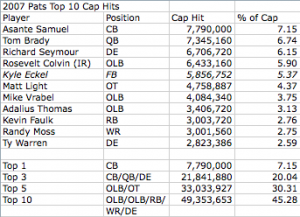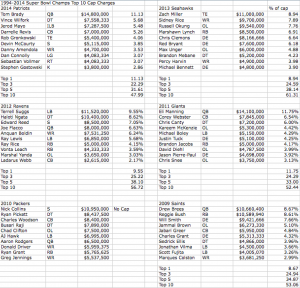This will be much like Jason’s Super Bowl series as I think that it created a whole new set of questions and analysis for it. When I look at the top cap charges of teams, I think of the main positions where spending should be in this era of football: quarterback, the men who protect him, players who catch his footballs, those who rush him, and the players who defend against the quarterbacks pass. So teams should be spending money on their quarterback, offensive line, defensive linemen (usually defensive ends), outside linebackers and cornerbacks. From here on out, let’s refer to those as “pass game positions.”
You also see how much they should spend on these positions, you see which positions shouldn’t be the top paid on a team, but should be in the top 10, which we really see illustrated at the wide receiver and outside linebacker positions for instance. Through gaining an understanding of how the best teams of the last 21 years have constructed their cap, we can figure out where teams should allocate their money at the top of the cap to succeed.
For those of you doing out GM series where you’re managing your favorite team, I think these Super Bowl teams are a great example of how you should build your team. For example, when looking at 2014 teams, I found that the Ravens and Chargers had punters in their top ten cap hits in Sam Koch and Mike Scifres respectively. No Super Bowl team has ever won with a punter in their top ten and while nothing is impossible, it’s probably not worth bucking two decades of salary cap spending. Plus, why spend top ten money on a player who only plays a few snaps a game? As vital as the field position battle is, isn’t that money better spent on one of the “pass game positions?”
To supplement this series, I’ve also brought in the top ten cap hits for the 2007 Patriots as they’re the only undefeated regular season team of the salary cap era. For all of their information, I’ve used Miguel’s PatsCap.com.
For the below figures, everything outside of the Patriots information we’ve gleamed from PatsCap.com comes from USA Today.
As always on these pieces, the tables are always more important than what I have to say.
Click on the figures to enlarge them.
Figure 1: 2009-2014 SB Champs
Figure 2: 2003-2008 Super Bowl Champs
Figure 3: 1997-2002 Super Bowl Champs
Figure 4: 1994-1996 Super Bowl Champs
Figure 5: Average for Super Bowl Champs
Figure 6: Cap Hit Breakdown of Top 1, 3, 5 and 10

Figure 7: Cap Hit by Set (This shows where in the Top 10 every position is, rather than just the all encompassing Top 10.)

Figure 8: 2007 Patriots (Please note, there are 11 here because the Patriots consistently finagle the cap by giving guys “Likely To Be Earned” incentives that they know they’ll never hit, so the cap space that ends up going unused rolls over into the next season. I’ve left Kyle Eckel in the Top 11, but I have not included him in the totals.)

When you really sit down and study these cap figures, then you look at what some current teams are doing or have done (which will be in my next article), it really makes you scratch your head because so much information is in these figures alone. Those punter figures I cited before being an example, another being Ndamukong Suh and Gerald McCoy taking up over 16% of their teams cap when Warren Sapp was the only Super Bowl defensive tackle who was his team’s number one cap charge and he only took up 9.82% of his teams cap. Of course, a team could win with these figures, but why try to do something that’s never been done before when the figures are in front of you? The Lions could certainly win with Suh as their top cap figure, he’s a Sapp-like player, but do they think he’s almost twice as good as Sapp? Because that’s what they’re saying by paying him almost double his cap percentage.
As Jason’s pointed out in the article Super Bowl Titles and Salary Cap Quarterbacks, the highest percentage of the cap that a quarterback took up was Steve Young in 1994 with 13.08% of the 49ers cap, so if that’s the highest that Super Bowl teams spend on most important position, then logic says that you shouldn’t spend more than that on a quarterback, let alone a defensive tackle or some other position. The highest cap percentage charge for a non-quarterback was Ty Law in 2004 taking up 12.67% of the Patriots cap.
The fact that the 2007 Patriots and many of this years best teams had top cap averages similar to the Super Bowl averages, leads me to believe that we are onto something with the correlation of the top cap charges, something that Jason was the first to turn me on to. The fact that the 2007 Pats were below the averages for all of the figures was a huge indication of how relatively inexpensive their incredible roster was. Brady being in a year where he restructured his deal to make room for additions like Randy Moss and Donte Stallworth was a huge reason for the lower average cap charges. It seems reasonable that we break it down into the top ten charges because that makes up about 50% of most NFL salary caps.
Through analyzing the 21 Super Bowl champs of the salary cap era, plus the undefeated Pats, I think that we’ll see there are multiple ways to build a roster and every team should look at what they have on their roster already, what they’re trying to do, and then going from there. It’s about figuring out what pieces fit, how they fit and sticking to your strategy from there.
Through analyzing this, you can easily see which positions teams should invest most heavily in, obviously being the pass game positions. You also see how teams compensate when they don’t have a position that every other team seems to have in the top ten.
The four positions that are most prevalent in the top ten are offensive line (34), defensive line (32), wide receiver (26) and quarterback (20). If you include outside linebackers for a 3-4 team like the 2012 Ravens with Terrell Suggs, then 71% of salary cap era Super Bowl champs had a passer, a pass blocker, a pass catcher and a pass rusher.
What does not show up in Figure 6 is defensive backs, there were 31 in the top ten of Super Bowl teams which means there are 1.48 DBs per team. Behind quarterbacks, cornerbacks have the second most number one cap hits with three. If you include defensive backs, which I suggest considering they’re the main pass defenders, then there are only eight teams without these five vital positional groups. I don’t think it’s a coincidence that 62% of champions have the same five positions locked into their top ten charges.
That leaves running back, tight end, defensive tackle and inside linebacker as non-vital positional groups. I would argue that tight end is fast becoming a vital group, but the other three positions are pretty indicative of a) a bygone era of football, as the NFL becomes more of a passing league every year and b) while I have no statistical analysis on hand to prove it, they might be the three positions that take the most damage because they’re so involved in the running game.
It’s also worth noting that three of the 16 running backs in the top 10 were fullbacks. They were Vontae Leach, Mike Alstott, and Daryl Johnston, Alstott was the only one of these three to rush the ball frequently as he had over 500 yards this season. I’m also unsure if we’ll ever again have a player like Mike Alstott, a fullback who runs the ball with such excitement that he’s a frequent highlight on ESPN. I’ll always remember his barreling ram runs where he’d break a handful of tackles with his unique and wild style. What a classic.
The teams that don’t have spending at these five pass game positions have compensated with spending elsewhere and spending in a way that works to their strengths and amplifies them. I think that analyzing the teams without all of these positions in their top ten, we’ll see other strategies of team building outside of that core philosophy. With a few of them, we’ll see how they drafted well to avoid spending big money on important positions, while getting Super Bowl caliber production out of them.
I think that philosophy should be at the center of roster building for every team, create a strong core at those four or five positions and build around them. Again, people who make the passing game go and those who stop the pass, it’s a pretty simple strategy, but also what allowed the Seahawks to become so dominant by focusing on their own strategy that allowed them to find value where others didn’t.
Many of the teams who didn’t have these five positions got by because they found value at these positions specifically and didn’t have to spend a lot of money to get Super Bowl caliber production, which we’ll get into below. Even when teams have spent a lot of money on the right positions, there still tends to be an element of great drafting at these important spots.
Teams without The Five Pass Game Positions in the Top Ten
With the 2013 Seahawks, they’re obvious because they were a run first team with Russell Wilson at quarterback for a third-round rookie deal, so they’re missing a quarterback in their top ten. As Jason and I have both said in previous articles, they have the strangest salary cap of the cap era. No team has ever had a cap that has been less consistent in terms of player spending and player production, many of their best players were at the bottom of their cap.
What was strange about the Seahawks was the fact that they had two wide receivers in their top ten, but the fact that Sidney Rice and Percy Harvin didn’t play all season and they still won the Super Bowl, showed them how little they needed to spend on wide receiver. While Zach Miller is the only tight end that’s a number one cap charge for a Super Bowl team and was a bit over paid, he’s one of the most consistent run blockers in the NFL, which goes with their run first philosophy. Being a run first team, they wisely made Marshawn Lynch their fourth highest cap charge, left tackle Russell Okung their third highest and center Max Unger their seventh.
They’re very similar to the 2000 Ravens, a top rushing attack with a historic defense. Also strange is the fact that they had no linebackers and no defensive backs in their top ten, but this is due to their incredible job drafting at these positions and if they win a Super Bowl in the near future, their top ten will be filled with LBs and DBs. Four of their top ten were defensive linemen in 2013 with three of them being defensive ends. Chris Clemons, Red Bryant and Michael Bennett combined for 14.5 sacks as three of the defensive ends in their rotation. Brandon Mebane was their eighth highest cap charge as a defensive tackle and had 45 total tackles on the year. They had a ton of great lower cost players who contributed to their pass rush, guys like Cliff Avril, Clinton McDonald, Bobby Wagner, and Bruce Irvin.
One of the pass game positions that the 2000 Ravens left out was wide receiver, which was a great move for them considering they didn’t need top receivers and that they had a top right end in Shannon Sharpe. That year, Sharpe had over 800 receiving yards and was a key cog on some of the greatest rushing teams of the cap era in the Terrell Davis Broncos and those Ravens team. So without him even being in their top ten charges, they got their top receiver and a very capable blocker.
The Ravens philosophy towards wide receivers was one that the Seahawks took this year by letting Golden Tate go, getting rid of Percy Harvin, giving Doug Baldwin a modest $3 million per year for the next three years and having a handful of very capable, but inexpensive receivers like Jermaine Kearse, Ricardo Lockette and Paul Richardson. They had much more success passing the ball than those Ravens due to Wilson’s abilities and a more balanced approach.
While I don’t think Pete Carroll and the Seahawks needed any affirmation, the Ravens and their experiences in 2013 gave them a decent insight into cap management with their strategy. I know he becomes more controversial by the day, but I’m a firm believer that the Cleveland Browns should implement this strategy with Manziel under center.
The 2011 Giants were only missing out on the wide receiver in the top ten, but Eli Manning had 4933 yards, which was the sixth most in a single-season at the time and strangely, fourth that year. They got this production with three receivers and a tight end on their rookie deals. Victor Cruz had his breakout season with over 1500 yards, Hakeem Nicks had almost 1200 and Mario Manningham had over 500. Jake Ballard slipped into the starting role in 2011 and had his only good season with over 600 yards.
The 2010 Packers were a team without a defensive end or outside linebacker in their top ten cap charges, but they had a young Clay Matthews who was the runner-up for Defensive Player of the Year that year and only cost $3.1 million, the Packers 17th highest cap hit. Matthews had 13.5 sacks that season, which was the fourth most in the season that year with DeMarcus Ware leading the way with 15.5 sacks for the Cowboys.
Cullen Jenkins, was their highest defensive end charge, 13th overall, at $4.57 million and had seven sacks in 11 games. BJ Raji, their third highest charge and a defensive tackle, had 6.5 sacks. So although they didn’t have the normal positions as high cap charges, they obviously still got a great pass rush that season. Desmond Bishop and Frank Zombo combined for seven sacks from the linebacker spots. The Packers had the second most sacks in the NFL with 47, one behind their Super Bowl opponent that year, the Steelers.
The 2006 Colts had the second best pass defense in the NFL, but didn’t have a defensive back in their top ten because they had four low-cost, valuable starters in cornerbacks Nick Harper and Jason David, plus young safeties in Antoine Bethea and Marlin Jackson. Nick Harper was the highest cap charge out of these four with a salary of only $1.4 million, which was the 20th highest charge on the team. They gave up only 2548 passing yards, but were last in the NFL against the run.
The 2005 Steelers were another team without a defensive back in their top ten, but low-cost players led their defensive backfield with Ike Taylor, Troy Polamalu and Chris Hope all on their rookie deals. DeShea Townsend was thirty years old and cost them $1.47 million as their right starting cornerback, Polamalu cost $1.99 million and they were 18th and 13th on the Steelers cap charges. Taylor and Hope both made less than $700,000 and each had almost 100 tackles and good production defending the pass.
What I think is a huge part of the Steelers making up for having a young, inexperienced defensive backfield was their pass rush. A great pass rush a huge part of pass defense that’s sometimes overlooked when we simply look at the cornerbacks as dominant, but don’t give their pass rushers the credit they deserve as pass stoppers. This 2005 team had the third most sacks in the NFL with 47, only three behind the Seahawks who they beat in the Super Bowl who had 50. Top cap hits, Aaron Smith, Joey Porter, and Kimo Von Oelhoffer combined for 16 of these sacks.
The 2004 Patriots were without an offensive lineman in the top ten, but were the seventh best rushing team in the NFL, which I think is a good indicator of their talent on the line. They also had Antowain Smith and Corey Dillon as their 11th and 21st cap charges, which allowed them to have a balanced attack with Brady. Their starting offensive line from left to right of Matt Light, Joe Andruzzi, Dan Koppen, Stephen Neal and Brandon Gorin cost them less than 5% of their cap, so rather than it being them under-spending on an important position, I think they just found valuable pieces. They had capable, but cheap back-ups in Adrian Klemm, Lonie Paxton, and Russ Hochstein.
The last team on this list of eight without all five pass game positions in their top ten was the 1996 Packers who didn’t have any offensive linemen, but had three linemen in the top fifteen and four of their five starters were on their rookie deals. They did a great job drafting and were rewarded by spending on 9.1% of the year’s cap space on the line, which is way below 2014’s average of 15.7%. This team was another example of a team benefitting from great scouting and building through the draft, something the Packers are well known for.
For risk of making this article more lengthy than it already is, I’m going to end it here. There are a couple things that might be coming next from me on this topic. I’m currently analyzing 2014 NFL teams and what top ten cap hits most hampered their ability to construct a Super Bowl champion roster. I’m also going to give my opinion on some of the best constructed rosters of these Super Bowl teams, I’m also trying to figure out how to classify the main spending strategies that Super Bowl teams have used to win according to their strengths as a team. For example, the pass-first 2006 Colts, should obviously be constructed much differently than the run-first, defensive minded 2013 Seahawks.
My mind is all over the place on this topic, but I hope to give you guys something in the next few days as I think this is a very interesting way for us to analyze the correct way to build a champion.
@ZackMooreNFL




